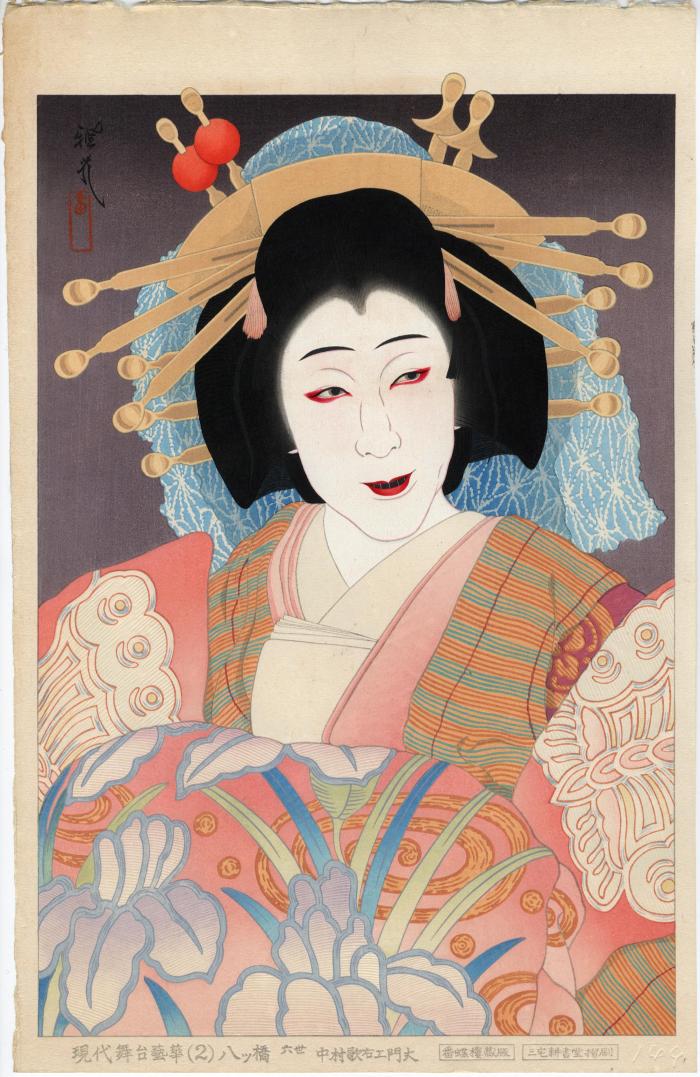Ōta Masamitsu (太田雅光) (artist 1892 – 1975)
Nakamura Utaemon VI (中村歌右衛門) as the courtesan Yatsuhashi (八ツ橋), number 2 from the series Flowers of Contemporary Theatre (現代舞台芸花)
1954
10.75 in x 16.75 in (Overall dimensions) Japanese woodblock print
Signed: Masamitsu (雅光)
Artist's seal in red
Number - embossed in lower right: 164 [of 200]
Printer's mark: Miyake Kōshōdō shosatsu
三宅耕書堂摺摺刷
Copyright: Banchōrō (番蝶楼蔵版)
Waseda University
Portland Art Museum
University of British Columbia Museum of Anthropology "An onnagata builds a mask-like face by applying dense white makeup and by pulling and tightening facial skin through various methods. Matsue V quoted his father Utaemon VI saying, “Your face is a living mask." Utaemon VI and other older contemporary onnagata emphasize the liveness of the onnagata face. They take pride in their faces' expressivity, saying it is one of their twentieth-century innovations to onnagata art. But this should not be misconstrued to mean free-form or realistic expression. Rather, there is a greater range of stylized facial expressions and methods of making up their features. Facial “expression” depends on the individual onnagata who finds his own way to manipulate the onnagata gender standards of facial beauty: small, delicate features in a moon shaped face. A nose with a high, narrow, and straight bridge is considered an additional asset. In ordinary situations, only slight movements of the eyes, a tiny puckering between the eyebrows, and pursing the lips make up the standard vocabulary of facial expressions. Depending on the role type, under emotional duress, there are additional stylized facial expressions and makeup that will distort the features. Onnagata use large and intense facial expression only under extreme conditions such as death, mourning, or radical transformation. In Japan, smiling with teeth showing is not considered beautiful. Utaemon VI added a large, mocking smile, almost a leering grin, to his famous courtesan role Yatsuhashi of Kagotsurube (Kagotsurube—the name of a famous sword). In this case, the courtesan role is reacting with this hideous grin to a jovial but ugly and pock-marked male country bumpkin character, who falls in love and gets used and refused. He eventually murders the courtesan. Utaemon VI’s wide toothy smile was considered an incredible innovation, but now has become a standard kata for that role. It is striking to see the perfect painted face and rose-bud mouth crack open so suddenly and flash the face beneath."
Quoted from: Beautiful Boys/Outlaw Bodies: Devising Kabuki Female-Likeness by K. Mezur, p. 191.
****
Illustrated in color in a full-page reproduction in the review by Katherine Saltzman-Li of Kabuki at the Crossroads: Years of Crisis, 1952–1965 by Samuel L. Leiter, Impressions, no. 36, 2015, p. 230.
actor prints (yakusha-e - 役者絵) (genre)
Nakamura Utaemon VI (六代目中村歌右衛門: 04/1951 to 03/2001) (actor)
Banchōrō (番蝶楼) (publisher)
Shōwa era (昭和時代) (genre)
